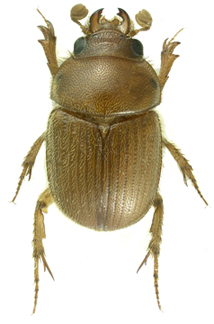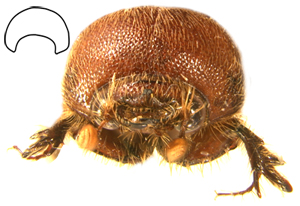| 1. | Larger mesotibial and metatibial apical spurs pectinate (Fig. 1); Body form elongate (Fig. 2). Restricted to western North America (only CA, OR). | |||||||
1'. |
Larger mesotibial apical spur pectinate, both metatibial spurs simple; Body form oval (Fig. 3). Widely distributed. | 2
(Ochodaeinae) |
||||||
|
||||||||
| 2. | Anterior margin of pronotum not simply concave, instead margin produced behind eyes (Fig. 4). Antenna with 9 antennomeres. Mandibles angulate externally. | |||||
2'. |
Anterior margin of pronotum simply concave (Fig. 5). Antenna with 10 antennomeres. Mandibles evenly rounded externally. | |||||
|
||||||
| 3. | Apex of elytra dentate, teeth interlocking with 2 tubercles on propygidial margin (Fig. 6). | |||
3'. |
Apex of elytra not dentate, instead evenly rounded; propygidium lacking tubercles (sulcus may be present on surface). | |||
|
||||
| 4. | Propygidium lacking sulcus. Male with mentum strongly produced Antennal club not strongly oval, last segment concave (Fig. 7). | |||||
4'. |
Propygidium with longitudinal sulcus (Figs. 9-10). Antennal club distinctly oval, last segment convex (Fig. 8). | |||||
|
||||||
| 5. | Propygidium long with elongate, subparallel sulcus (Fig. 9). Mentum distinctly longitudinally impressed from apex to base. | |||||
5'. |
Propygidium short, with trapezoidal sulcus (Fig. 10). Mentum flat, only weakly impressed apically. | |||||
|
||||||









